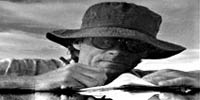Spring Skiing in the Wasatch

 4:01
Scott Carrier
4:01
Scott Carrier
A day of spring skiing in the Wasatch Range.
Broadcast: May 17 2006 on NPR Day to Day Subjects: Environment, Sports
Spring Skiing in the Wasatch Range
May 17, 2006 from Day to Day
MADELEINE BRAND, Host: On a May Day like this one, many of us think of heading to the beach, the lake, maybe a pool somewhere - but writer Scott Carrier thinks about mountains, snow, and skiing.
(Soundbite of music)
Mr. SCOTT CARRIER (Radio Producer, Writer): Sometimes I have nothing better to do than sit on my porch in Salt Lake City and watch how the mountains change shape with the light. The map fixes them at 11,000 feet above sea level, 15 miles away on a straight line. But Iíve seen them grow taller and shorter, creep up on the city after a snowstorm, and slink away in the summerís heat. I watch the mountains and wonder how long it would take me to get up there and which way I would come down and what it would be like. It all depends on the time of year, the time of day, and the weather.
If itís May, and 2:00 p.m., and my neighbor is mowing his grass in his shorts, and if in the evening the sky is clear and I wear a coat and hat to sit on my porch and drink beer, and if at night looking down on the city - the lights twinkle and move in a mirage - then I know I have to set my alarm for 5:00 a.m. to get up early and go spring skiing.
It takes an hour and a half to make coffee, eat some oatmeal, and drive up the canyon to the base of the mountain called Superior. Itís southeast face is a white wave, 3,000 feet tall, a slope that gets progressively steeper and then curls over at the top in a cornice. At 6:30, the sun is hitting the top of the peak and the snow up there is red and warm, while everything under the shadow is blue and cold.
In winter, the snow in the Wasatch is light and dry powder, the best in the world. But in spring, the big flakes melt into small ice balls, and the snow pack becomes a consolidated sheet, five to 10 feet thick. This sheet freezes hard at night, and then in the day the surface melts to the consistency of a slurpee. So the trick in spring skiing is to get up high and be ready to ski down just as the surface is starting to melt. An inch or so of soft snow on top of a hard base is really fun, easy to hold your edge, and very fast. But thereís a narrow window of time here. If you start down too early, youíre skiing on ice. If you go too late, itís like skiing in mush and kind of dangerous, because it sometimes slides down the mountain in an avalanche.
(Soundbite of footfalls in snow)
I reach the ridge about 500 vertical feet from the top, and there are fresh coyote tracks following the crest line of snow toward the summit. I follow the tracks to the top and see that when he got there, he didnít even break stride, just kept going down the north ridge - no time for epiphanies. Itís 9:30 and I look down on the valley and see a brown layer of smog over the city from morning rush-hour traffic. I look for my house, my neighborhood, but itís under the smudge.
I take my skies off my backpack and put them on my feet. Iíd rather have wings, but skies will do. I take the top part carefully, like a raven checking out a picnic, then drop through a chute like a dive-bombing falcon, then traverse across the slope at high speeds like an albatross skimming over the ocean. The snow is soft and smooth and fast, just what I thought it would be. My timing is immaculate.
Iím at my truck by 9:55, and back home on my porch drinking coffee by 10:45 - time to go to work. That is, if I had a job other than looking up at the mountains and watching how they change shape with the light.
(Soundbite of music)
BRAND: Scott Carrier lives in Salt Lake City, Utah. Heís part of the radio collective, HearingVoices.com.
(Soundbite of music)
BRAND: DAY TO DAY is a production of NPR News, with contributions from Slate.com. Iím Madeleine Brand.

